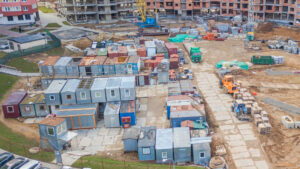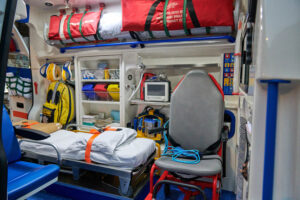
What’s Included in Oil and Gas Facilities Management
Oil and gas facilities management is a complex and critical discipline that ensures energy operations in Canada’s most remote locations

Budgeting for facility repair and maintenance in remote Canadian work sites is no small task. When miles away from urban infrastructure and local trades, a broken heater or damaged plumbing can mean more than just inconvenience—it may disrupt entire operations. Collaborating with a specialized camp management company can make the difference between reactive scrambling and proactive planning. To keep the gears turning in far-flung locations like diamond mines, oil rigs, or forestry camps, a well-thought-out repair budget is critical.
Remote sites across Canada face logistics unlike anywhere else. From the frigid territories of the Yukon to the vast expanses of northern Alberta, facilities need to withstand harsh weather and operate independently. The best remote work locations may offer stunning views and rich natural resources, but they also bring limited access to repair personnel and long delays for material delivery.
Facilities in these areas often rely on a remote camp facility—a centralized hub designed for both living and operations. However, damage in these areas isn’t rare, and maintenance must be both swift and cost-efficient. That’s where early collaboration with a camp management company becomes essential. These firms bring experience, resources, and expertise to the table—making them indispensable when planning long-term repair budgets.
Developing a practical budget means involving the right people. A remote site manager has the boots-on-the-ground experience, while remote camp service providers add strategic oversight. Together, they can evaluate repair histories, anticipated wear and tear, climate-related risks, and seasonal fluctuations.
By integrating data from a remote site monitoring system, teams can pinpoint vulnerabilities before they become costly emergencies. For instance, predictive algorithms can track changes in facility usage, temperature, or equipment performance—allowing maintenance in building construction to be timed with maximum efficiency.
Camp management companies can also streamline vendor relationships, coordinate remote facility janitorial services, and organize remote scheduled tasks management. Their holistic approach minimizes overspending and ensures no detail is overlooked.
Here’s a pragmatic framework for budgeting for facility repair and maintenance in collaboration with camp managers:
Tools like remote construction site monitoring play a key role here, offering data that enhances planning accuracy. With continuous remote maintenance tracking, costs can be anticipated rather than estimated blindly.
Across the remote industry, budgeting isn’t just about crunching numbers—it requires insight into the distinct conditions and operations of each site. From exploration facility management to oil and gas facility maintenance, each location brings its own repair priorities. For instance, an exploration camp might experience frequent equipment wear due to mobility, while a mining site may struggle with dust-related ventilation issues.
Working with firms that specialize in remote site camp services significantly improves budget accuracy. These companies understand the specific challenges of remote site management, including waste systems, snow removal, and emergency protocols—all of which influence repair schedules and costs. Whether managing a remote camp facility, overseeing remote site administration, or coordinating construction facility maintenance, they bring operational clarity and historical insights into the budgeting conversation.
Many sectors share common challenges when managing repairs in rugged terrain. Whether it’s a diamond mine camp management team in Nunavut or forestry remote facility maintenance staff in British Columbia, success depends on proactive planning and informed partnerships. Those in exploration facility management or research remote site management have increasingly turned to technologies like remote site monitoring systems, which use predictive analytics to anticipate wear and reduce downtime. Combined with the knowledge of camp management companies, this hybrid approach offers a full-spectrum understanding of future needs and associated costs
Modern solutions are changing the repair game. Remote site monitoring systems now offer real-time alerts, heat mapping, and performance reports. This means you don’t have to wait for a site visit to discover a fault—you can act immediately. For construction facility maintenance, sensors detect structural strain before visible signs emerge, allowing preemptive reinforcements.
Similarly, platforms dedicated to research remote site management consolidate data, automate reports, and link budgeting with facility conditions. With machine learning models, camp managers can forecast repair cycles, allocate costs accurately, and even suggest budget adjustments mid-year.
Technology alone isn’t enough. Successful budgeting depends on open, frequent conversations between stakeholders. Remote site managers must communicate real-time observations, and camp management companies must remain agile, adapting to unexpected developments.
Transparency about repair costs—especially around variables like labor premiums or freight charges—is crucial. While exploration facilities and forestry camps may seem similar, they often diverge in fuel consumption, weather exposure, and frequency of equipment replacement. Recognizing those nuances is what turns an average budget into a resilient one.
Here are practical reminders for teams budgeting for facility repair and maintenance:
Ultimately, budgeting for facility repair and maintenance is not just about money—it’s about creating a culture where maintenance is proactive, not reactive. Camp management companies are key drivers of this change, ensuring that teams are trained, systems are monitored, and repairs are scheduled before failures occur.
From remote construction site monitoring to leveraging insights from remote industry veterans, this collaborative approach ensures operational longevity and financial sustainability. Every dollar spent upfront in planning and preventative work saves multiple dollars down the line in emergency fixes and lost productivity.

In Canada’s remote operations, survival hinges on proactive thinking. Whether its oil and gas facilities or diamond mine camps, unpredictability is the norm—and that means reactive maintenance simply won’t cut it. Camp management companies lead the charge in shifting to a culture where teams are trained, systems are closely monitored, and repairs are scheduled before breakdowns occur.
By embracing innovations like remote site monitoring and applying the wisdom of seasoned industry veterans, organizations can reduce emergency costs and avoid productivity slumps. The focus isn’t just on keeping things running—it’s about creating long-term operational resilience through collaboration, strategy, and foresight.
In the vast wilderness of Canada, budgeting for facility repair and maintenance has evolved into more than a spreadsheet exercise—it’s a blueprint for survival and success.
Strengthen Your Remote Operations with Strategic Insight
Partner with the Domco Group for expert support in budgeting for facility repair and maintenance. Build solutions that make your remote site better prepared, more efficient, and future-proof. Contact us today to start building smarter strategies.
Domco Group of Canada Limited is one of the most trusted and well respected remote sites service providers in Canada. Fully Canadian and independently owned, Domco has been in operation since 1945. We offer integrated remote site solutions, including a nutritious and well planned menu cycle, long-term relationship building, and deep Canadian roots in remote locations with Aboriginal communities.
Let us take you through some key advantages that set us apart.

Oil and gas facilities management is a complex and critical discipline that ensures energy operations in Canada’s most remote locations

In the rugged, often isolated world of remote construction camps, construction facility management is the invisible force that sustains daily

Remote maintenance is the backbone of operational continuity in Canadian work camps, especially those located in isolated regions supporting industries

Remote camp health and safety is a vital concern in the management of Canadian remote workforce camps, especially in resource-driven

Keeping crews energized and satisfied starts with smart camp food menu ideas—especially in remote environments where morale and nutrition go

Gas remote camp mobilization is a critical operational phase in Canada’s oil and gas industry, particularly in remote and northern

When it comes to remote site security in Canadian work camps, ensuring safety and protection is paramount. These facilities, often

In Canada’s vast and resource-rich landscapes, remote site maintenance plays a pivotal role in sustaining the operations of work camps

In Canada’s vast and often isolated regions, remote camp management plays a vital role in advancing sustainability across diverse work

Remote site administration is a vital function in Canada’s most geographically isolated and operationally demanding environments. From the Arctic’s frozen

Developing a sustainable infrastructure for a remote camp facility located in the rugged, often isolated regions of Canada—such as the

In Canada’s vast and rugged landscapes, remote facility catering has evolved from a logistical challenge into a platform for sustainable

Budgeting for facility repair and maintenance in remote Canadian work sites is no small task. When miles away from urban

The process of gas remote camp mobilization in Canada is a critical operation that supports the development and maintenance of

Remote facility chefs are the unsung heroes of Canada’s sprawling wilderness operations—from fly-in camps tucked into diamond-rich tundras to energy
